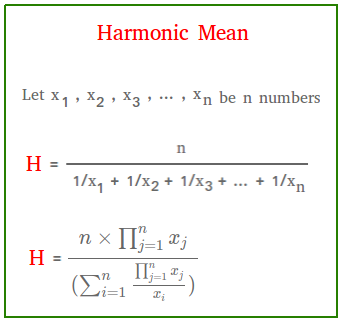Harmonic mean
The harmonic mean (H) of n numbers ( x1, x2, x3, ... , xn ), also called subcontrary mean, is given by the formula below.

If n is the number of numbers, it is found by dividing the number of numbers by the reciprocal of each number.
What is the formula to find the harmonic mean of two or three numbers?
Suppose there are two numbers x1 and x2.
Suppose there are 3 numbers x1, x2, and x3.
Examples showing how to calculate the harmonic mean
Example #1:
Find the harmonic mean of 3 and 4
Example #2:
Find the harmonic mean of 1, 2, 4, and 10
A linear motion problem that leads to the harmonic formula.
A car travels with a speed of 40 miles per hour for the first half of the way. Then, the car travels with a speed of 60 miles per hour for the second half of the way. What is the average speed?
First notice that it is not possible to use directly the speed formula since we do not know for how long the car kept driving with a speed of 40 m/h and then 60 m/h. However, with some manipulation, we can still tackle the problem.
Let d be the first half of the total distance.
Let t2 be the time it took to travel the second half of the total distance
Let d be the second half of the total distance.
Total time = t1 + t2 = d/40 + d/60
Total distance = d + d = 2d
Now replace these in the formula
Now, you can see that it looks like we are calculating the harmonic mean for 2 numbers by using the formula above.
Another way to express the harmonic mean of n numbers
This is going to challenge you a bit. However, do not give up. Keep reading and you will get it! Furthermore, make sure you perfectly understand fractions before reading this section of the lesson.
Here is our strategy:
Step 1. Express the harmonic mean of two or three numbers in a different way.
Step 2. Examine carefully step 1 by looking for patterns and make a generalization using the summation symbols and the product symbols.
Rewriting the harmonic mean of two numbers
At this point, notice that we rewrote the denominator x2 + x1. Why did we do that? We did this because we want the x1x2 to appear in three different places (once on top and twice at the bottom)
This will help us to factor the bottom part of the complex fraction as you can see below.
Rewriting the harmonic mean of three numbers
Notice again that we rewrote the denominator x2x3 + x1x3 + x1x2. Why did we do that? We did this because we want the x1x2x3 to appear in four different places (once on top and three times at the bottom)
Again, this will help us to factor the bottom part of the complex fraction as you can see below.
Summary
For 2 or 3 numbers, here is what we have so far!
For n numbers, here is what we will have then!
For n numbers, we can make the formula look a little better or more generalized by using the summation symbol and the product symbol mentioned earlier. Using the product symbol, we get:
And using also the summation symbol, we get:
See an example of harmonic mean related to the stock market.